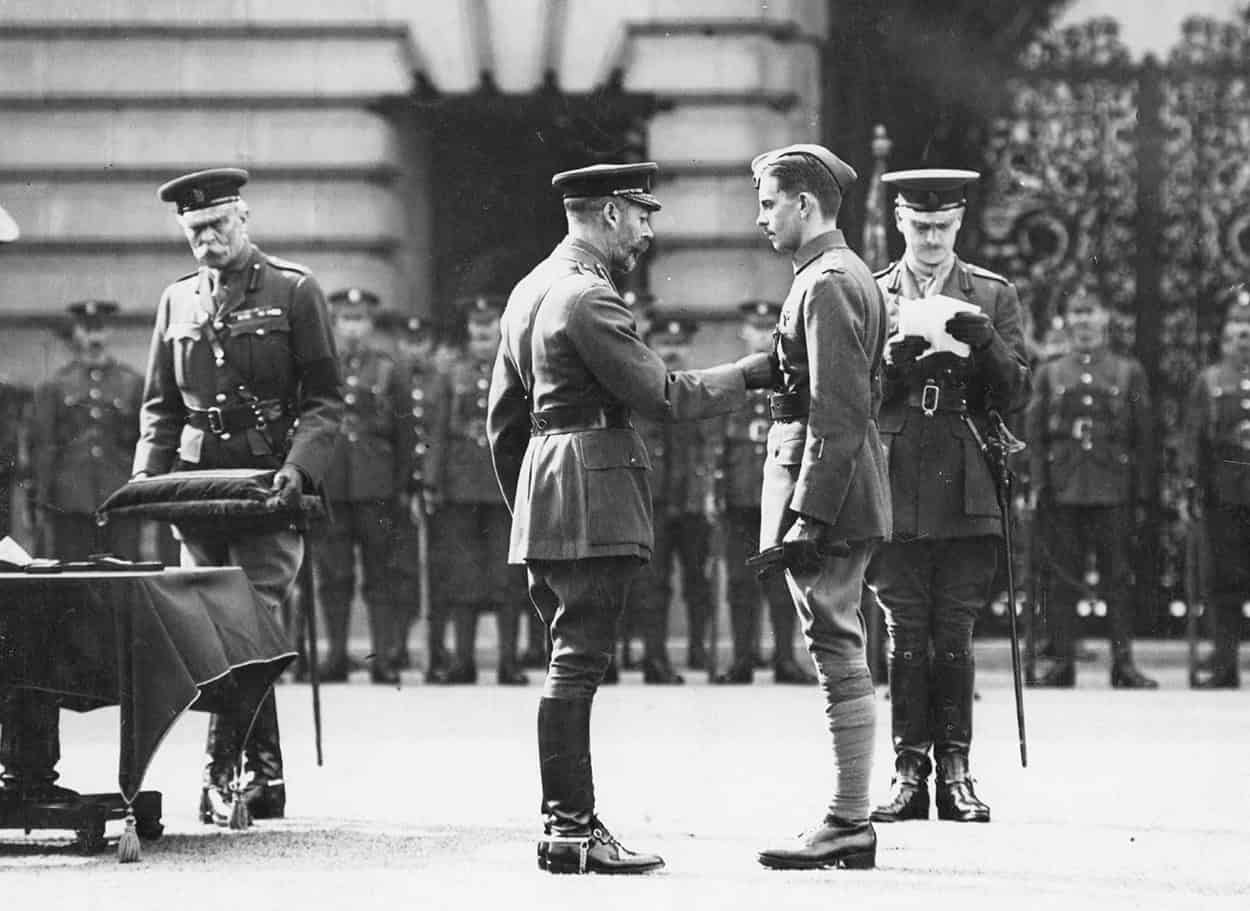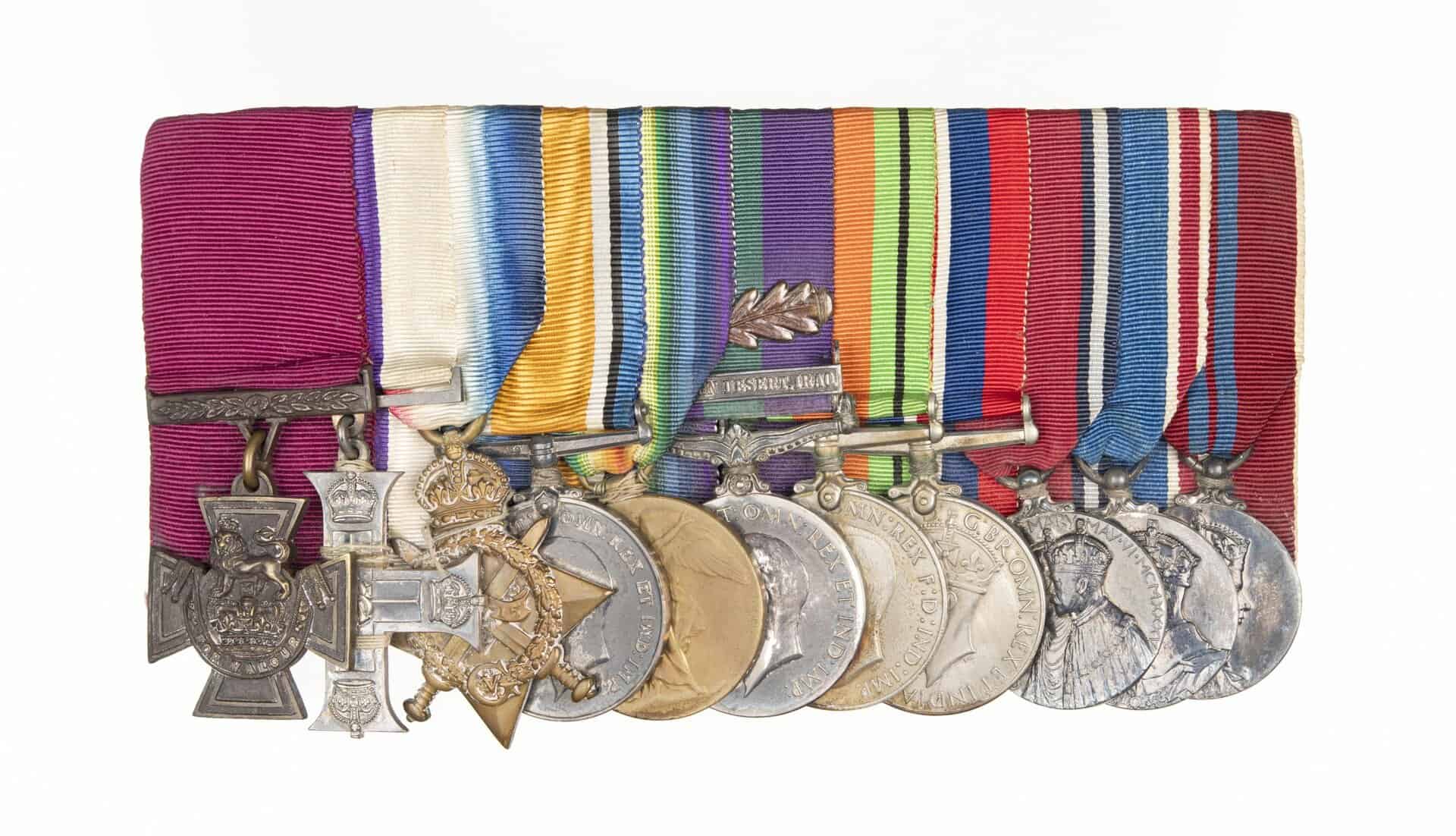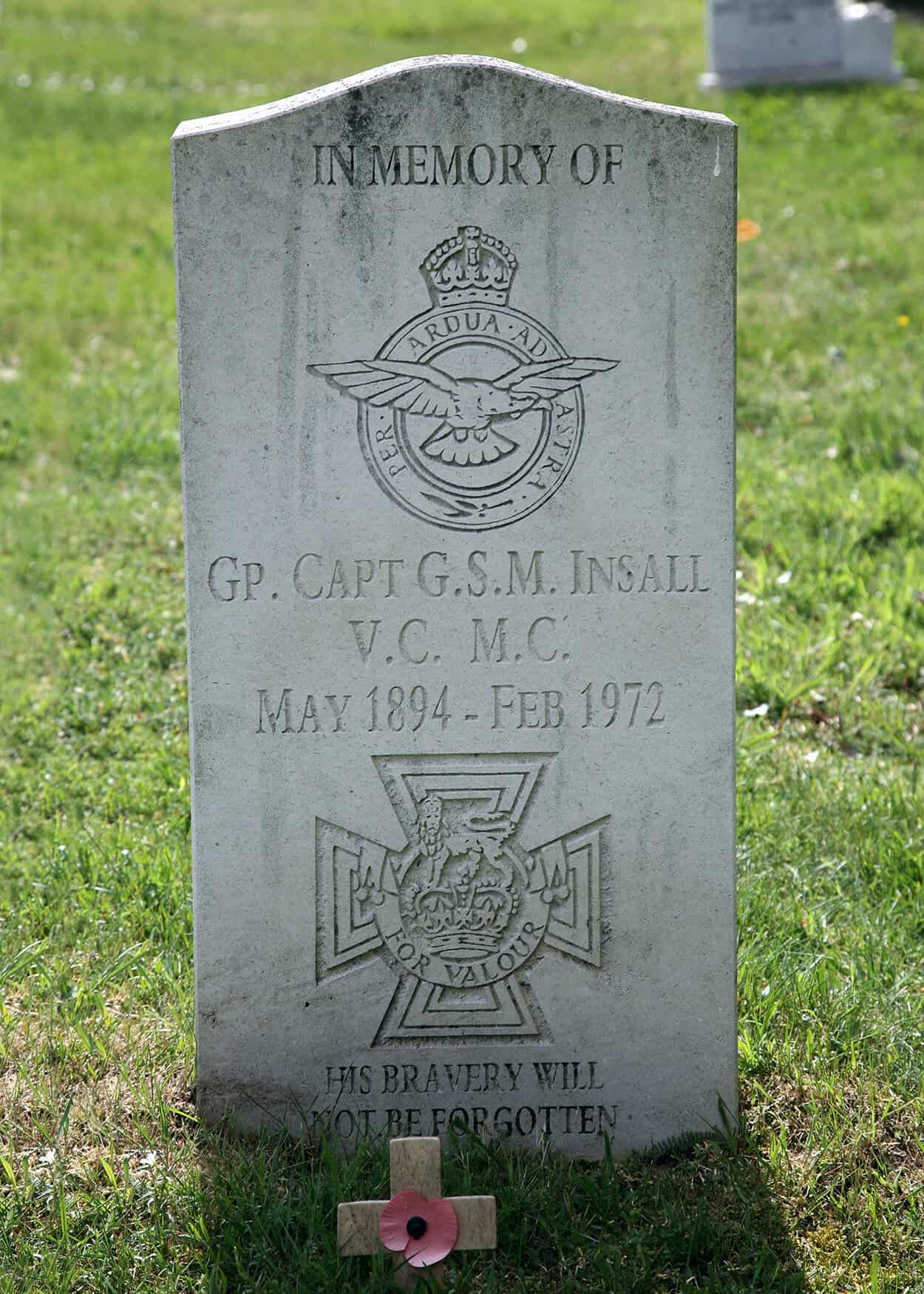November 7 1915, over France

Second Lieutenant Gilbert Stuart Martin Insall, VC, Royal Flying Corps
14 May 1894 – 17 February 1972
Insall joined the army as a Private in September 1914 but transferred to the Royal Flying Corps in March 1915. After qualifying as a pilot, in July 1915 he was appointed to 11 Squadron in France at Vert Galand aerodrome, flying a Vickers FB5 aircraft. This was a ‘pusher’ design with the engine behind the pilot and a gunner in front. With a small bomb load as well, the FB 5 could barely manage 60 mph.
 Gunbus, serial 5486, 11 Sqn RFC, over Albert (© RAF Museum X003-2602/17023)
Gunbus, serial 5486, 11 Sqn RFC, over Albert (© RAF Museum X003-2602/17023)
 Gunbus detail: note pusher propeller and gunner is ahead of pilot for unobstructed field of fire. Also skid to prevent ‘nosing-over’ on soft ground.
Gunbus detail: note pusher propeller and gunner is ahead of pilot for unobstructed field of fire. Also skid to prevent ‘nosing-over’ on soft ground.
(© RAF Museum X003-2602/17054)
At that time, the FB 5 was used principally as an escort fighter to bombing raids, though 11 Squadron also undertook bombing and reconnaissance flights, moving in September 1915 to Villers Bretoneux. On 7 November, Insall was assigned to a ‘fighting patrol’ along the front lines, flying FB 5 serial 5074 and with Air Mechanic First Class T H Donald as his gunner.
 Insall and Sgt Watts, Brooklands 1915; the aircraft is a Bleriot
Insall and Sgt Watts, Brooklands 1915; the aircraft is a Bleriot
(© RAF Museum X004-7598/020)
12798 SUPPLEMENT TO THE LONDON GAZETTE, 23 DECEMBER 1915
His Majesty the KING has been graciously pleased to award the Victoria Cross to the
undermentioned Officer: Second Lieutenant Gilbert Stuart Martin Insall, No 11 Squadron, Royal Flying Corps.
For most conspicuous bravery, skill and determination, on 7th November, 1915, in
France. He was patrolling in a Vickers Fighting Machine, with First Class Air Mechanic T. H. Donald as gunner, when a German machine was sighted, pursued, and attacked
near Achiet.
 King George V presenting Gilbert Insall with the Victoria Cross, 26 September 1917
King George V presenting Gilbert Insall with the Victoria Cross, 26 September 1917
(© RAF Museum X004-7598/020)
The German pilot led the Vickers machine over a rocket battery, but with great skill Lieutenant Insall dived and got to close range, when Donald fired a drum of cartridges into the German machine, stopping its engine.
The German pilot then dived through a cloud, followed by Lieutenant Insall. Fire was again opened, and the German machine was brought down heavily in a ploughed field 4 miles south-east of Arras. On seeing the Germans scramble out of their machine and prepare to fire, Lieutenant Insall dived to 500 feet, thus enabling Donald to open heavy fire on them.
The Germans then fled, one helping the other, who was apparently wounded. Other Germans then commenced heavy fire, but in spite of this, Lieutenant Insall turned again, and an incendiary bomb was dropped on the German machine, which was last seen wreathed in smoke. Lieutenant Insall then headed west in order to get back over the German trenches, but as he was at only 2,000 feet altitude he dived across them for greater speed, Donald firing into the trenches as he passed over. The German fire, however, damaged the petrol tank, and, with great coolness, Lieutenant Insall landed under cover of a wood 500 yards inside our lines.
 Capt Gilbert Insall VC in 50 Squadron SE5a, RAF Bekesbourne
Capt Gilbert Insall VC in 50 Squadron SE5a, RAF Bekesbourne
(© RAF Museum X003-2602/12077)
The Germans fired some 150 shells at our machine on the ground, but without causing material damage. Much damage had, however, been caused by rifle fire, but during the night it was repaired behind screened lights, and at dawn Lieutenant Insall flew his machine home with First Class Air Mechanic T.H. Donald as a passenger’.
 Medal Bar of 11: Victoria Cross; Military Cross; 1914-1915 Star; War Medal 1914-1918; Victory Medal; General Service Medal 1918-1962; Defence Medal; War Medal 1939-1945; Jubilee Medal 1935; Coronation Medal 1937; Coronation Medal 1953
Medal Bar of 11: Victoria Cross; Military Cross; 1914-1915 Star; War Medal 1914-1918; Victory Medal; General Service Medal 1918-1962; Defence Medal; War Medal 1939-1945; Jubilee Medal 1935; Coronation Medal 1937; Coronation Medal 1953
(© RAF Museum X002-8838)
Insall continued combat flying with 11 Squadron but his luck ran out on 14 December 1915 when his FB 5 was forced down behind German lines and, wounded, he became a PoW. Undaunted, Insall made a number of escape attempts, finally succeeding on 28 August 1917 when he made his way across the [neutral] Dutch border. He could not fly combat again but now a Captain, took up training responsibilities, followed by the command of 51 (Home Defence) Squadron in Kent. Insall remained in the RAF post-war following a meritorious career, finally retiring as Group Captain in 1945.
A much more comprehensive review of his life and the VC action may be found in ‘For Valour, the Air VCs’ by Chaz Bowyer (see Bibliography); a copy may be studied in the Reading Room at RAF Museum, Hendon.
Insall’s Victoria Cross is held by RAF Museum, Hendon.

Memorial to Group Captain Insall VC MC
(© The War Graves Photographic Project)
He was cremated at Rose Hill Crematorium in Doncaster. His ashes were interred in Nocton Churchyard, Nocton, Lincolnshire and a memorial headstone has been erected in Rose Hill Cemetery, Doncaster.
Credits:
Citation: London Gazette 23 December 1915
Additional biographical details: ‘For Valour: The Air VCs’ Chaz Bowyer, Grub Street Publishing.
‘The Madness of Courage’, Tony Insall; Biteback Publishing 2025